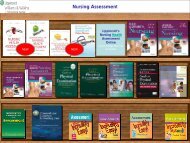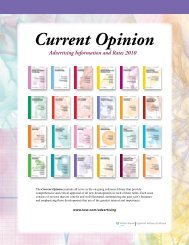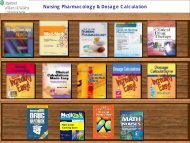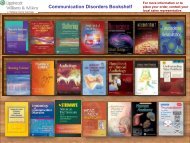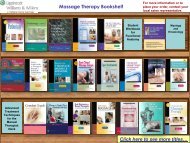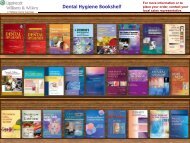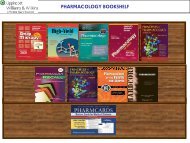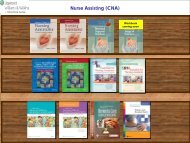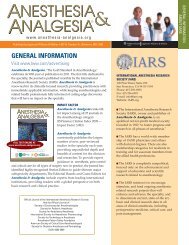anatomy & embryology bookshelf - Lippincott Williams & Wilkins
anatomy & embryology bookshelf - Lippincott Williams & Wilkins
anatomy & embryology bookshelf - Lippincott Williams & Wilkins
- No tags were found...
You also want an ePaper? Increase the reach of your titles
YUMPU automatically turns print PDFs into web optimized ePapers that Google loves.
Clinical Anatomy by SystemsRichard S. SnellApril 2006 / 960 pp./ 650 illus./ 978-0-7817-9164-9Student Resources:• Packaged with a free studentCD-ROM containing clinicalnotes, information oncongenital anomalies,radiographic <strong>anatomy</strong>, andclinical problem solvingexercises.Features:• First <strong>anatomy</strong> textbook on the market featuring a systemsbasedapproach. This approach caters to those medicalprograms who have adopted an integrated, organsystem-based curriculum.• Chapter opening outlines highlight the importantconcepts students should take away from each chapter.• Basic <strong>anatomy</strong> sections supply basic information fordiagnostic and treatment purposes and for performingmedical procedures. Numerous imaging examples andlabeled photographs of cross-sectional <strong>anatomy</strong> areincluded.• Surface <strong>anatomy</strong> sections provide surface landmarks ofimportant anatomic structures located beneath the skinand often bypassed by practicing medical personnel.• Physiologic notes and embryologic notes are interspersedwith basic anatomical material to point out the functionalsignificance of the material and provide developmental<strong>anatomy</strong> information that is it is essential for theunderstanding of the structure and relationships oforgans.• End-of-chapter review questions and answers make the book avaluable resource for student board and course review.• Extensive use of color.
Fundamental AnatomyWalter Hartwig PhDFebruary 2007 / 304 pp./ 287 illus./ 978-0-7817-6888-7Student Resources:• Fully searchable onlinetext (via thePoint)No instructor ancillaries.Features:• Developmental perspective emphasizing both<strong>embryology</strong> and <strong>anatomy</strong>• Systems-based approach, which reinforces organizationand development• Concise, conversational tone that aids retention• Continuously applied models providing context formaterial learned• Organ system organization for quick reference• Selective Clinical Anatomy boxes• Full-color artwork helps students grasp concepts• Continuously applied models providing context formaterial learned• Organ system organization for quick reference• Selective Clinical Anatomy boxes• Full-color artwork helps students grasp concepts
<strong>Lippincott</strong> <strong>Williams</strong> & <strong>Wilkins</strong> Atlas ofAnatomyPatrick Tank PhDThomas R. Gest PhDFebruary 2008 / 448 pp./ 750 illus./ 978-0-7817-8505-1Instructor Resources:• Interactive image bankwith slideshow and jpg/PDFexport features.• Access to Moore, ClinicallyOriented Anatomy's questiontest bank, which containsapproximately 500 reviewquestions with answers.Student Resources:• Online interactive atlasw/all of the images• Online e-flashcardsFeatures:• 750 brand-new images, including clinical images• Each plate teaches specific structures and relationshipsdisplayed using artistic techniques such as "ghosting,"layering, and color selectivity--to help students quickly graspanatomical concepts.• Labeling is clear and uncluttered and is limited to the• anatomical concept being highlighted.• A vibrant, colorful palette appeals to student preferences, whilecolor coding of anatomical elements imparts pedagogicalconsistency.• Extensively reviewed by anatomists worldwide to ensureaccuracy• Images are presented in anterior and posterior views, as well aslateral and medial views where appropriate.• Anatomical terminology is consistent with standard anatomicalnomenclature (Terminologia Anatomica).
Grant’s Atlas of Anatomy 12eAnne M.R. Agur BSc (OT), MSc, PhDArthur F. Dalley II, PhDFebruary 2008 / 834 pp./ 1623 illus./ 978-0-7817-9604-0Instructor & StudentResources:• Grant's Interactive Atlas• Numerous video clipsfrom Acland's DVD Atlas ofHuman Anatomy• Image Bank• 110 "Dissection Sequence“Power Point slides• 300 interactive USMLE-style<strong>anatomy</strong> review questions• 90 image-based labelingexercises• 20 electronic flash cards fromGould's Clinical AnatomyFlash CardsFeatures:• NEW! Replacement of gray skin with lifelike skin tones inGrant's artwork• NEW! Brighter color palette for additional Grant'sillustrations• NEW! Enhanced clinical information highlighted for easyreference• NEW! schematic drawings to create a more consistentand vibrant art style• NEW! Greater ethnic diversity in surface <strong>anatomy</strong>photographs and in colorization of skin in Grant'sillustrations• NEW! Improved autonomic and lymphatic drawings andlayouts• NEW! replacement bone photographs to improvequality• Boldfaced primary labels in images• A companion Website on thePoint will offer student
Acland's Cross-Sectional NavigatorStudent Version CD-ROMRobert D. Acland MD, FRCSJune 21, 2005/978-0-7817-6199-4Features:• Never before have the images from the Visible Humanproject been available in digital-quality. For the first timeever, CSN provides 1350 high-resolution images from theVisible Male library, allowing users to see cross-sectional<strong>anatomy</strong> as never before.• Intuitive navigation system allows users to quickly and easilylocate the structures they wish to study. Interface includes ahuman silhouette to provide longitudinal orientation throughthe body. Major regions and areas of the body are alsocolor-coded for quick click access.• View images in increments of 1, 5, 10, or 100 slices. Each slicefrom the Visible Male project is one millimeter per slice.• View images with labels and leader lines, with leader linesonly (for self testing), or without labels or leader lines.• An Instructor's version of CSN will also be available, allowinginstructors to easily export images into Microsoft PowerPoint.
High-Yield Gross Anatomy 4eRonald W. Dudek PhDMarch 9, 2010 / 336pp / Approx. 211 illus. / 978-1-60547-763-3Features:• NEW! Closer placement of images with appropriate text• NEW! Enlargement of selected CTs and MRIs• NEW! New tables on upper and lower extremity innervation• NEW! Reduction in content/statements regarding histology,<strong>embryology</strong>, and pharmacology• NEW! Reduction of non-<strong>anatomy</strong> clinical correlations• NEW! Reduction of vertebral fractures in Chapter 1• NEW! Replacement of keys in legends with full labels on images• NEW! Shortened paragraphs with addition of bullet points, whereappropriate• Clarifies difficult concepts• Clinical considerations• Comprehensively illustrated with a combination of line drawingsand radiographic images• Helps equip students for the <strong>anatomy</strong> questions on USMLE Step 1• Includes coverage of some clinical techniques to teach relatedgross <strong>anatomy</strong> relationships (e.g., liver biopsy, tracheostomy,lumbar puncture)• Integrates relevant clinical <strong>anatomy</strong> with case studies• Provides a quick review of gross <strong>anatomy</strong>• Surface <strong>anatomy</strong>, radiology, and cross-sectional <strong>anatomy</strong>• Written from a clinical perspective to prepare students for clinicalvignettes on the USMLE
Anatomy Recall 2eJared L. AntevilLorne H. BlackbourneChristopher MooreNovember 2005 / 384 pp/ 134 illus./ 978-0-7817-9885-3Features:• Concise, affordable, pocket-sized review of the fundamentals of human<strong>anatomy</strong>• Popular two-column, question-and-answer Recall Series format facilitatesquick learning through repetition• Highlights the most important anatomic principles, with a wealth ofillustrations and anatomic correlations to clinical problems• An ideal study guide for medical students in pre-clinical coursework,undergraduate or nursing <strong>anatomy</strong> study, clinical rotations, and boardreviewNew Features:• Updated by expert authors, including anatomists, medical students, andsurgeons• Expanded coverage now includes highlights, summarizing key anatomicprinciples of human <strong>embryology</strong>• Clinical Pearls emphasize important clinical correlations to anatomicprinciples• Surgical Anatomy Pearls help 3 rd and 4 th year medical students toprepare quickly for the most common intraoperative <strong>anatomy</strong> questions
Clinical Anatomy for your PocketDouglas J. GouldSeptember 16, 2008 / 224 pp./ Approx. 50 illus /978-0-7817-9193-9Ancillary Assets:• Online USMLE reviewquestions delivered viathePointFeatures:• 15-25 overview/orientation full-color images from Tank/Gest:<strong>Lippincott</strong> <strong>Williams</strong> & <strong>Wilkins</strong> Atlas of Anatomy• A consistent systems-based approach within each chapter• Additional select clinical images• Follows organization of Moore: Clinically Oriented Anatomyand Agur/Dalley: Grant's Atlas of Anatomy• Learning/memory tricks: mnemonics, clinical relevance, andanalogy for each region• Regionally organized Table of Contents (Thorax, Abdomen,Pelvis/Perineum, Back, Lower Limb, Upper Limb, Head, Neck)• Table-formatted content with additional, limited bullet-pointtext• Easy-to-read flipbook format
Rohen’s Photographic AnatomyFlash CardsJoel A. VilenskyDr. Johannes W. Rohen MDChihiro Yokochi MDElke Lütjen-Drecoll MDJanuary 2008 / 440 pp./ 220 illus./ 978-0-7817-7835-0Features:• The only gross <strong>anatomy</strong> flash card set that includes full-colorphotographs of actual cadaver dissections, allowing studentsto prepare for lab dissections and study for practical laboratoryexams• Realistically depicts anatomic structures as seen on the cadaver• Cross-referenced to the leading photographic <strong>anatomy</strong> atlas,Color Atlas of Anatomy: A Photographic Study of the Human Body,Sixth Edition• Approximately 220 flash cards• The front of each card shows an image with key structureslabeled• The back of each card has hints to help identify the structure,as well as relevant clinical pearls• Hole-punched in corner for on-the-go key-ring portability
Clinical Anatomy Flash CardsDouglas J. Gould PhDApril 26, 2007/ 696 pp./ Approx. 452 illus./ 978-0-7817-6509-1Features:• 350 full-color flash cards featuring essentials of <strong>anatomy</strong>• Clinical "Blue Box" correlations from Clinically Oriented Anatomy• Grant's images serve as the primary front of the card image andaugment and complement the COA clinical focus• Identifies images as "COA" or "Grant's" and features COA chaptercolor coding• Provides complete clinically relevant regional approach to <strong>anatomy</strong>• Images include color illustrations and photographs• Features concise versions of COA's clinical "Blue Boxes"• Includes surface <strong>anatomy</strong>, regional location of important vesselsand nerves, musculature that is commonly strained, bony elementsthat are commonly broken, ligaments commonly sprained, andother structures that are of interest to physicians in training• Cards are titled and numbered independently within sections toallow for easier reorganization and flexibility of use• Images are labeled with 5-10 labels per image, the amount studentsindicated they preferred• Developed based on extensive market research (focus groups withstudents)• COA's organization, clinical concepts and correlating images serveas the backbone organizational tool• Student friendly design for easy learning and retention• Packaged in a sturdy box for easy storage and portability• Muscle attachments, innervations, and main actions.
Clemente's Anatomy Flash CardsThomas R. Gest PhDMay 17, 2007 / 700pp / Approx. 350 illus. / 978-0-7817-6526-8Features:• Regionally organized and includes images from Clemente: Anatomy5e• Cards include images with self-testing labels (numbers on front withanswers on back)• Sturdy and colorful packaging, heavy coated cards and tabbedindex cards for each region• Additional information appears on back of cards in tabular format forbones, muscles, nerves, arteries, veins, ligaments, topographicfeatures, lymphatics, and organs• Tables for arteries include: source, branches, supply, notes• Tables for bones include: structure, description, notes• Tables for ligaments include: description, significance• Tables for lymphatics include: location, afferents from, efferents from,regions drained, notes• Tables for muscles include: origin, insertion action, innervations, notes• Tables for nerves include: source, branches, motor, sensory, notes• Tables for organs include: location/description notes• Tables for topographic features include: boundaries/description,significance• Tables for veins include: tributaries, drains into, region drained, notes
BRS Gross Anatomy Flash CardsBoard Review SeriesTodd Swanson MD/PhDSandra Kim MD/PhDJuly 24, 2004 / 254pp / 978-0-7817-5654-9Description:• BRS Gross Anatomy Flash Cards take a clinicallyrelevantapproach to the study of gross <strong>anatomy</strong>,highlighting the need-to-know information forcourse and USMLE Step 1 review.• The concise format of the cards allows for a highyieldreview and easy retention of the studiedconcepts and structures. Students can add theirown notes to the cards to build a morepersonalized study aid.• BRS Gross Anatomy Flash Cards can be used aloneor in conjunction with the BRS Gross Anatomy text.
<strong>Lippincott</strong>'sIllustrated Q&AReview of Anatomyand EmbryologyCover ImageComing Soon<strong>Lippincott</strong>'s Illustrated Q&A Review ofAnatomy and Embryology<strong>Lippincott</strong>'s Illustrated Q&A ReviewH. Wayne Lambert PhDLawrence Wineski PhDJuly 15, 2010/Approx. 219 illus./224pps./978-1-60547-315-4Features:• 400-500 multiple-choice questions with detailedexplanations of correct and incorrect answers• Clinical images portray signs and symptoms andradiological images (ultrasounds, PET scans, MRIs, CTscans, and X-rays)• Includes questions related to clinical topics in Moore:Clinically Oriented Anatomy and Sadler: Langman'sMedical Embryology.• Includes USMLE-style clinical vignette questions as well assome content review questions• Companion website offers an Interactive Question Bankwith test and study modes, providing flexible studyoptions
Langmans Medical Embryology 11eThomas W. Sadler, PhdJanuary 30, 2009 / 414pp / Approx. 320 illus. / 978-0-7817-9069-7Online Student Resources:• Fully searchable text• Interactive review questions andproblems• Simbryo animations ofembryologic organ and systemdevelopment: this edition includesupdated and additionalFeatures:• NEW! Additional images included in the birth defects chapters toprovide more visual examples and improve the usability of thechapter• NEW! Additional recolorization/replacement of line drawings(approximately 15-20)• NEW! Continued replacement/addition of color clinicalphotographs/images• NEW! Glossary of key terms• NEW! Updated and new Problems to Solve• NEW! Updated information on molecular genetics• Clinical Correlates provide information about birth defects andother clinical entities directly related to embryologic concepts• Full-color art program along with supporting color clinical imagesand photographs• General chapter on development includes coverage of molecularbiology• Organized into two parts:--Part One, General Embryology, presents development of embryochronologically and also includes chapters on placental and fetaldevelopment and prenatal diagnosis and birth defects--Part Two, Systems-based Embryology, describes the embryogenesisof each organ system• Provides end-of-chapter Summaries and Problems to Solve
High-Yield Embryology 4eHigh-Yield SeriesRonald W. Dudek PhDOctober 2009 / 208 pp./120 illus./ 978-1-60547-316-1Features:• NEW! "Key to Know" added to case studies• NEW! 3 new line drawings, 5 new clinical images, 1 newtable• NEW! Enlarged figures• NEW! Male and female Tanner stages• NEW! Previous Chapters 14-17, 21-24 removed• Clinical boxes and USMLE-style case studies• Includes radiographs/photographs of many congenitaldefects• Since most medical schools do not have a strongcourse in <strong>embryology</strong>, medical students want a quick,focused review book; this is the niche for High-YieldEmbryology• Written from a clinical perspective to prepare students forclinical vignettes on the USMLE
BRS Embryology 4eBoard Review SeriesRonald W. DudekJune 2007 / 304 pp./ 88 illus./ 978-0-7817-7116-0Instructor Resources:• Fully searchable online text• Interactive question bank onthePointFeatures:• Succinct outline-format review• End-of-chapter USMLE-style review questions• Comprehensive USMLE-style examination at the end of the book• Includes radiographs, sonograms, computedtomography scans, and photographs of variouscongenital malformationsNew to the Fourth Edition:• Content updates• New organization: prefertilization through the embryonicperiod; system by system; genetic abnormalities; and teratology• Substantially revised chapter on structural chromosomalabnormalities• Review questions are in the clinical vignette-based format of thecurrent USMLE
Fundamental AnatomyWalter Hartwig PhDFebruary 23, 2007 / 304pp / Approx. 287 illus. / 978-0-7817-6888-7Features:• Developmental perspective emphasizing both <strong>embryology</strong> and<strong>anatomy</strong>• Systems-based approach, which reinforces organization anddevelopment• Concise, conversational tone that aids retention• Continuously applied models providing context for material learned• Organ system organization for quick reference• Selective Clinical Anatomy boxes• Full-color artwork helps students grasp concepts• Continuously applied models providing context for material learned• Organ system organization for quick reference• Selective Clinical Anatomy boxes• Full-color artwork helps students grasp concepts• Fully searchable text available online via the Point
Langman's Essential Medical EmbryologyThomas W. SadlerAugust 2004/150 pages/575 illus./978-0-7817-5571-9Features:• Eleven chapters cover basic principles of development earlydevelopment, embryogenesis, development of musculoskeletal system,central nervous system, heart, face, eye/ear, lungs and gut, kidneysand genital system, and fetal period and birth• Emphasis is placed on illustrating development, with the minimumnecessary amount of supporting text, helpingstudents to focus on the key concepts• Includes 320 full-color illustrations and 120 b/w clinicalimages, mostly taken from the renowned Langman's Medical Embryology• Large 9 x 12 format allows illustrations to be prominently presented.Clinical correlations provide students with valuable tools to help themunderstand the clinical implications of <strong>embryology</strong>• Glossary of key terms• Packaged with Simbryo Version 1.1, a suite of six animationsshowing three-dimensional embryologic development over time,helping students grasp spatial relationship in human development



